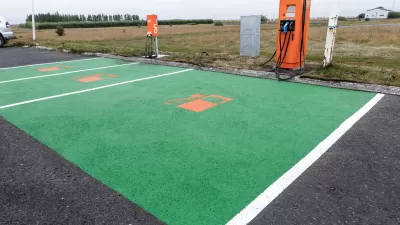Governments need money to finance transportation system improvements, but revenues from traditional sources are flat. This is leading to debate over how best to generate new funds. There are many possible options, some better than others, because in addition to raising revenue, they support other strategic objectives. Politicians will be tempted to choose the easiest funding options. It is up to planners to point out the best options, taking into account all impacts.
Governments need money to finance transportation system improvements, but revenues from traditional sources are flat. This is leading to debate over how best to generate new funds. There are many possible options [PDF], some better than others, because in addition to raising revenue, they support other strategic objectives. Politicians will be tempted to choose the easiest funding options. It is up to planners to point out the best options, taking into account all impacts.
Although vehicle travel has peaked in most developed countries, reducing the need for roadway expansion, many roads and transit systems are due for major maintenance and reconstruction, and demand for alternative modes is increasing [PDF]. In response to aging population, rising fuel prices, increased urbanization, increased health and environmental concerns and changing consumer preferences, many communities want to improve their sidewalks, cycling facilities and public transit services. This requires money.
Peaking vehicle travel, increasing fuel efficiency, and the fact that per-gallon fuel taxes do not increase with inflation means that real (inflation-adjusted) tax revenue per vehicle-mile driven is only about half what it was thirty years ago. Gasoline taxes and road tolls now finance only about half of total road spending, the rest is funded through general taxes. As a result, some experts to claim that the transport finance system is “broken” and must be replaced.
This has lead to various new transport funding proposals. Theoretically, the best involves charging road user fees that vary by time and location, which can internalize and therefore reduce costs such as congestion and pollution emissions. Recent studies demonstrate that the technology works. However, this approach requires installing instruments in each vehicle to track when and where it is driven in order to impose new, more complex fees. Despite the theoretical benefits this would surely face even more opposition than proposals to raise fuel taxes.
On the other hand, some politicians want to finance transport improvements through general taxes instead of user fees. For example, Virginia Governor Bob McDonnell recently proposed replacing the state’s 17.5-cent gas tax with an increase in the state’s sale tax from 5% to 5.8% dedicated to transportation expenditures. This is foolish. It would force residents who drive less than average to cross-subsidize their neighbors who drive more than average, and by reducing the marginal cost of driving will stimulate more vehicle travel which will increase traffic congestion, accidents and pollution emissions. The Governor’s proposal seems to reflect the illusion that a 0.8% tax on a broad range of consumer goods looks smaller than a 17.5¢ tax on a specific good.
Experts are too quick to dismiss fuel taxes. They are very cheap to collect (there is virtually no administrative cost to increasing existing fuel taxes), are no more regressive than most other taxes, and they support other planning objectives including congestion reduction, safety, energy conservation and emission reductions. Instead of dismissing them, governments should increase them to account for increasing fuel efficiency and inflation during the last few decades. The result would be revenue plus a more efficient transport system.
The potential benefits are significant. The U.S.’s high traffic fatality rates (the highest among peer countries) is largely explained by low fuel prices, which stimulate more per capita vehicle travel and therefore more traffic deaths. Financing transport improvements through fuel tax would save lives [PDF].
Communities should perform a comprehensive and systematic analysis of potential transport funding options. Earlier this month I presented a paper at the Transportation Research Board Annual Meeting which did this. Local Funding Options for Public Transportation [PDF] evaluates eighteen potential funding options according to eight criteria including potential revenue, public acceptance and ease of implementation, predictability and sustainability, horizontal and vertical equity, travel impacts, and support for strategic development objectives. Although this paper focuses on public transit funding, most of the analysis is transferable to any transport project or service.
In general, direct user fees are the most efficient and equitable road funding option. With cost-based pricing, residents who reduce their annual vehicle travel, for example, by commuting by cycling for errands or commuting by public transit, saves money, an option that is not possible if roads are funded by general taxes. This suggests that fuel taxes, road tolls, VMT fees and per space parking levies are the best roadway financing option.
Of course, motorists don't want to pay more than they do now, but transportaton infrastructure is costly and there are no magic solutions. It is up to transportation professional - planners, engineers and economists - to tell the whole story: some funding options solve more problems than others. It is up to us to communicate this important concept to decision-makers and the general public during tranpsort funding debates.
For More Information
Joseph Henchman (2013), Gasoline Taxes and Tolls Pay for Only a Third of State & Local Road Spending, The Tax Foundation (www.taxfoundation.org); at http://taxfoundation.org/article/gasoline-taxes-and-tolls-pay-only-third-state-local-road-spending.
Edward Huang, Henry Lee, Grant Lovellette and Jose Gomez-Ibanez (2010), Transportation Revenue Options: Infrastructure, Emissions, and Congestion, Belfer Center, Harvard Kennedy School (www.belfercenter.org/enrp); at http://belfercenter.ksg.harvard.edu/files/Transportation%20Revenue%20Options%20Workshop%20Report%202010%20for%20web.pdf.
Penelope Lemov (2013), “What to Do About the Gas Tax? Two states, two different approaches for fixing how we pay for roads,” Governing Magazine; at www.governing.com/columns/public-finance/col-gas-tax-virginia-oregon.html.
Todd Litman (2010), Raise My Taxes, Please! Evaluating Household Savings From High Quality Public Transit Service, VTPI (www.vtpi.org); at www.vtpi.org/raisetaxes.pdf.
Todd Litman (2010), Parking Pricing Implementation Guidelines: How More Efficient Pricing Can Help Solve Parking Problems, Increase Revenue, And Achieve Other Planning Objectives, Victoria Transport Policy Institute (www.vtpi.org); at www.vtpi.org/parkpricing.pdf.
Todd Litman (2011), Pricing For Traffic Safety: How Efficient Transport Pricing Can Reduce Roadway Crash Risk, Victoria Transport Policy Institute (www.vtpi.org); at www.vtpi.org/price_safe.pdf.
Todd Litman (2012), “Changing North American Vehicle-Travel Price Sensitivities: Implications For Transport and Energy Policy,” Transport Policy, July (http://dx.doi.org/10.1016/j.tranpol.2012.06.010); at www.vtpi.org/VMT_Elasticities.pdf.
Todd Litman (2013), Local Funding Options for Public Transportation, Paper 13-3125, Transportation Research Board 2013 Annual Meeting (www.trb.org); at www.vtpi.org/tranfund.pdf.
NSTIFC (2009), Paying Our Way: A New Framework Transportation Finance, Final Report of the National Surface Transportation Infrastructure Financing Commission (http://financecommission.dot.gov); at http://financecommission.dot.gov/Documents/NSTIF_Commission_Final_Report_Advance%20Copy_Feb09.pdf.
Ken Orski (2013), “Searching for Novel Approaches to Transportation Funding” Innovation NewsBriefs, Vol. 24, No. 1; at www.publicceo.com/2013/01/searching-for-novel-approaches-to-transportation-funding.
Stephen L. Reich, Janet L. Davis and Braden Sneath (2012), Florida MPOAC Transportation Revenue Study, Center for Urban Transportation Research for the Florida Metropolitan Planning Organization Advisory Council (www.mpoac.org); at www.mpoac.org/revenuestudy/RS_FINAL_REPORT.pdf.
Ko Sakamoto (2010), Financing Sustainable Urban Transport, GTZ Sourcebook Module, Sustainable Urban Transport Project (www.sutp.org) Asia and the German Technical Cooperation (www.gtz.de/en); at www.sutp.org/dn.php?file=1f-FSUT-EN.pdf.
Jeffery J. Smith and Thomas A. Gihring (2003), Financing Transit Systems Through Value Capture: An Annotated Bibliography, Geonomy Society (www.progress.org/geonomy); also at www.vtpi.org/smith.pdf.
TRB (2006), The Fuel Tax And Alternatives For Transportation Funding, Special Report 285, Transportation Research Board (www.trb.org); available at http://onlinepubs.trb.org/onlinepubs/sr/sr285.pdf.

Alabama: Trump Terminates Settlements for Black Communities Harmed By Raw Sewage
Trump deemed the landmark civil rights agreement “illegal DEI and environmental justice policy.”

Planetizen Federal Action Tracker
A weekly monitor of how Trump’s orders and actions are impacting planners and planning in America.

The 120 Year Old Tiny Home Villages That Sheltered San Francisco’s Earthquake Refugees
More than a century ago, San Francisco mobilized to house thousands of residents displaced by the 1906 earthquake. Could their strategy offer a model for the present?

Opinion: California’s SB 79 Would Improve Housing Affordability and Transit Access
A proposed bill would legalize transit-oriented development statewide.

Record Temperatures Prompt Push for Environmental Justice Bills
Nevada legislators are proposing laws that would mandate heat mitigation measures to protect residents from the impacts of extreme heat.

Downtown Pittsburgh Set to Gain 1,300 New Housing Units
Pittsburgh’s office buildings, many of which date back to the early 20th century, are prime candidates for conversion to housing.
Urban Design for Planners 1: Software Tools
This six-course series explores essential urban design concepts using open source software and equips planners with the tools they need to participate fully in the urban design process.
Planning for Universal Design
Learn the tools for implementing Universal Design in planning regulations.
Clanton & Associates, Inc.
Jessamine County Fiscal Court
Institute for Housing and Urban Development Studies (IHS)
City of Grandview
Harvard GSD Executive Education
Toledo-Lucas County Plan Commissions
Salt Lake City
NYU Wagner Graduate School of Public Service






























